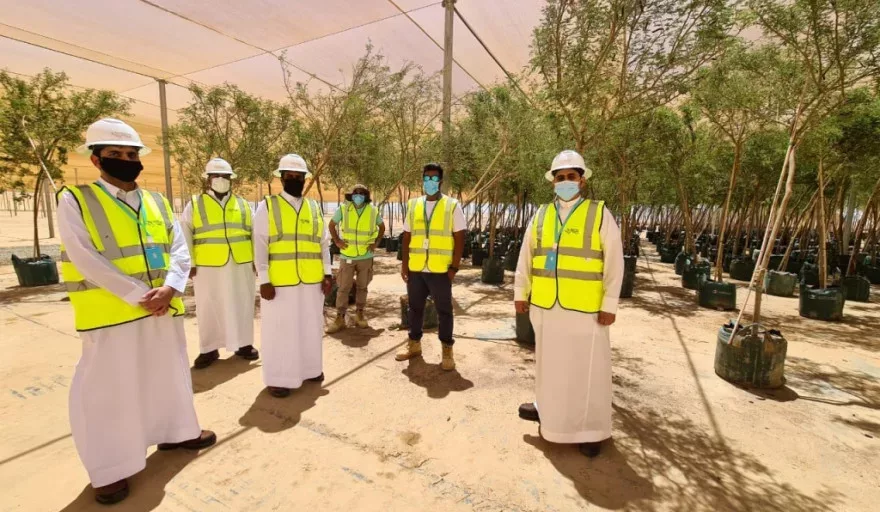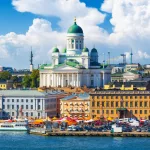How the Red Sea Project relies on innovative technologies to achieve its ambitious sustainability goals.
Picture 90 untouched islands in the translucent waters of the Red Sea, an archipelago of dormant volcanoes, deserts, mountains and coral reefs.
They fringe 200 kilometres of Saudi Arabia’s western coast, its cultural heritage apparent in the petroglyphs carved into its rock formations. This is the site of The Red Sea Project, a tourism initiative aiming to set new standards in sustainable development while introducing the world to this pristine environment.
“The Red Sea Project is one of the world’s most ambitious sustainable tourism developments, bringing together luxury, authentic cultural experiences, and a sustainable approach in one of the world’s last natural hidden treasures on the Red Sea coast of Saudi Arabia,” explains Dr Rusty Brainard, the project’s Chief Environment Officer.
The project, which aims to welcome guests in 2022, has ambitious sustainability goals: not only is it aiming for 100 percent carbon neutrality, it would also like the destination to contribute a 30 percent net conservation benefit over the next two decades.
“For us, a truly sustainable approach has to be baked into the project from the outset as opposed to an afterthought. This means that from destination planning all the way through to welcoming guests in 2022, a concern for environmental protection, preservation, and enhancement has to always remain a priority,” Dr Brainard explains.
Smart planning
The Red Sea Project’s first task was to undertake an ambitious Marine Spatial Planning (MSP) programme in partnership with the King Abdullah University of Science and Technology (KAUST).
Using innovative technology, it digitally surveyed and mapped out the 28,000 square kilometre project area, which gave it an unprecedented insight into any potential environmental impact of its development and helping it to minimise environmental harm.
“As a result of the MSP efforts, we have been able to identify key areas in need of protection and have designated nine islands as special conservation zones. We will also leave 75 percent of the destination’s islands untouched,” Dr Brainard says.
“We are presently in the process of conducting extensive habitat mapping and ecosystem assessments that will provide scientifically robust baseline measurements used to monitor our progress toward achieving our ambitious enhanced sustainability goals, while protecting all of the endangered and threatened species that call The Red Sea Project home.”
When it comes to technological innovation, MSP is only the beginning.
“For us at The Red Sea Project, technology and sustainability are intimately linked – with technology allowing us to find new and more effective ways of protecting and preserving the natural environment that makes our destination so special,” says the Chief Environment Officer.
“Beyond the Marine Spatial Planning programme which informs every stage of our destination development and future management, we’re investing heavily in new technologies to enable our vision for a truly sustainable tourism project.”
The project’s environmental and sustainability team will use state of the art Structure-from-Motion (SfM) photogrammetry to collect 3D images of the project site’s coral reefs, which will help monitor vital rates of corals. Working with KAUST and other partners, it hopes to design machine learning tools that will conduct automated analyses of these images.
Technology also plays a vital role in ensuring the destination remains carbon neutral. The team is investigating innovative solutions for sequestering carbon, including marine algae farms and mechanical trees.
Furthermore, the project site will be incorporating integrated smart sensors, which will provide real-time observations about the status of the environment, such as the abundance and movement patterns of wildlife, water and air quality readings, and the environmental impacts of human activity. This data will enable the team to better protect the natural environment.
A commitment to sustainability
As construction begins on the Red Sea Project, adhering to sustainable principles continues to be of paramount importance. Buildings are made using innovative ‘green concrete’, and prefabricated and modular construction techniques will reduce the environmental impact of the project. The project’s aim is for every element of construction to secure LEED gold or platinum certification upon completion.
“As work on site ramps up, we’ve made a number of commitments to ensure that we’re developing responsibly and sustainably,” Dr Brainard says.
“For instance, we currently have a large Public Private Partnership (PPP) in the market to sustainably provide all of the key utilities for the Project, including100% renewable energy (24 hours a day via solar and wind power), water production, and waste management.
“Regarding waste management, we’re ambitiously striving for zero waste to landfill once the destination is operational. In addition, we’ll be implementing a ban on single-use plastics policy at our islands and inland sites.”
Dr Brainard outlines an ambitious Clean Mobility Strategy that means only hydrogen-powered and electric vehicles (eventually even short-range aircraft) will be able to operate in the destination. It has also partnered with architecture firm Foster + Partners on the design of an international airport with innovative climate control technology.
In short, sustainability permeates every aspect of the project, from its goal to operate solely by using renewable energy to encouraging sustainable agriculture, so that a third of food consumed at the project’s hotels and restaurants is locally produced. And then there’s the goal to achieve 30 percent net positive conservation benefits.
“We’re striving to achieve this through enhancement of biologically diverse habitats, including coral reefs, mangroves, seagrasses, and native land vegetation, which will enhance both biodiversity and tourism benefits, as well as contributing to our carbon neutrality commitment,” Dr Brainard says.
The project is also hoping to become an accredited International Dark Skies Reserve, and is working with a development firm, Cundall, on a lighting plan that protects nocturnal wildlife and marine life.
Throughout COVID-19, the Red Sea Development Project has endeavoured to progress with development while ensuring the safety of its staff team. Dr Brainard believes that while the pandemic has been economically disruptive, it has also changed the way people think about international travel.
“With much more of a focus now being placed on protecting the planet and traveling sustainably, sometimes called regenerative travel, destinations like The Red Sea Project – with a philosophy of preserving and enhancing the integrity of the environment whilst delivering authentic experiences – are likely to see a higher demand,” he concludes.


































